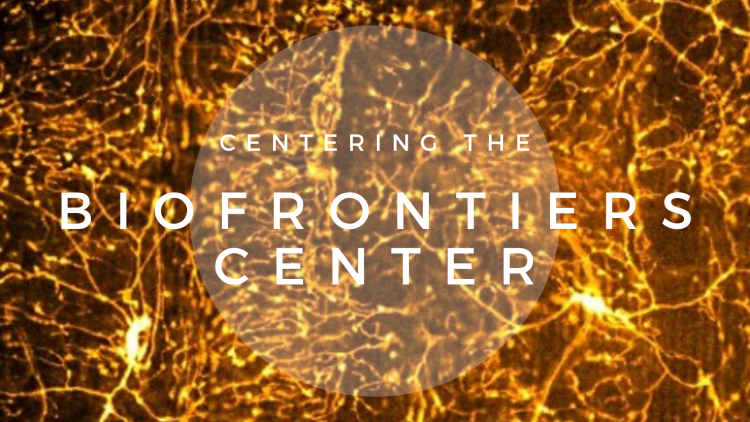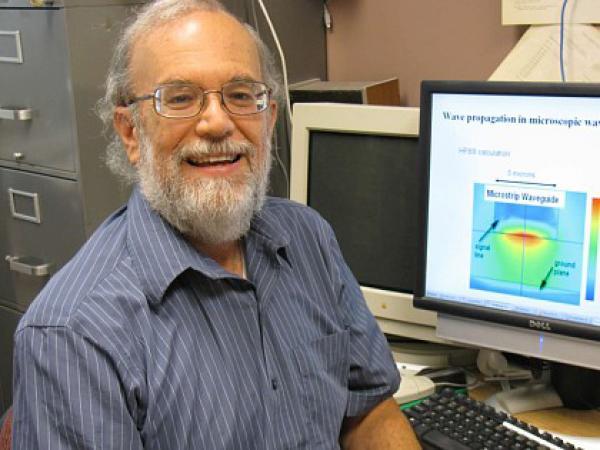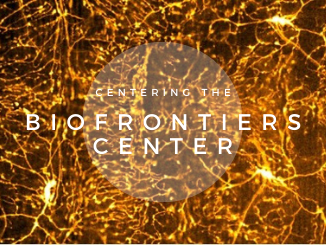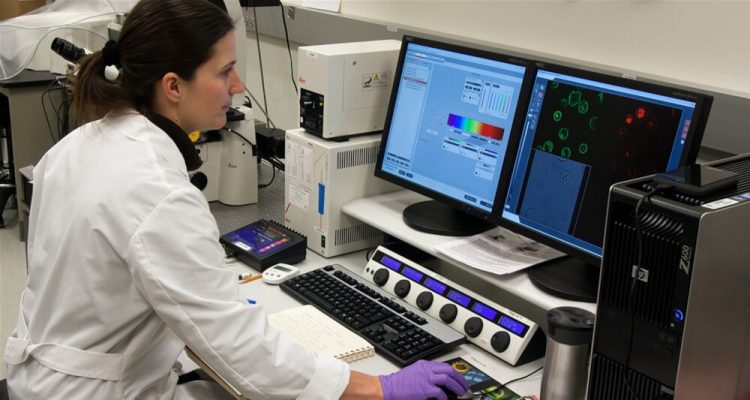
The UCCS BioFrontiers Center bridges the fields of biology and physics — and in doing so, aims to create new ways of seeing and manipulating nature. Its goal? To revolutionize human health.
The applications of the interdisciplinary science the BioFrontiers Center conducts are vast. From new diagnostic tools — like the development of a method to “see” temperature in MRI images — to new therapeutic treatments — like nanoparticules that can both detect and kill cancers — the Center is focused on expanding the frontiers of biotechnology.
Housed on the first and fourth floors of the Osborne Science and Engineering Building at UCCS, the BioFrontiers Center creates opportunities for faculty, students and research associates to collaboratively solve pressing health and biotechnology problems. In just a few years, the Center’s faculty and research associates have published over 130 research papers, received over 1,700 citations to their work, and guided over 150 students through cutting-edge work in the Center’s laboratories and facilities.
To learn more, we sat down with Bob Camley, Director of the BioFrontiers Center and Distinguished Professor of Physics. Read Camley’s interview below.
1. Describe how and why the UCCS BioFrontiers Center was started.
Contents
- 1 1. Describe how and why the UCCS BioFrontiers Center was started.
- 2 2. How does the Center’s work align with your own background?
- 3 3. Share a project, piece of research or initiative the Center has advanced that you’re proud of.
- 4 4. What is one of the most surprising things you’ve learned as Center Director?
- 5 5. What do you see as the next big topic or issue the Center will tackle in the next year?
- 6 6. Is there a project or program that never got off the ground that you wish you could reignite?
- 7 7. What part of the Center’s work most excites or inspires you?

The Center was started as a UCCS initiative to bring multiple disciplines together to improve human health and advance biotechnology. This was done in conjunction with the founding of the BioFrontiers Institute (centered in Boulder) and funded by the CU Foundation.
While the primary focus of the Center has been biophysics, we have also supported work in biology, computer science, chemistry, engineering, mathematics and psychology.
2. How does the Center’s work align with your own background?
My primary background is in theoretical physics, but I spent a couple of years working as an engineer for a company that made integrated circuits. I also spent several years working with an immunologist at UCCS. This broad background gave me an appreciation for the fascinating questions and issues in biology and the different methods to approach these issues.
Oh….I can’t list just one. We have projects to do all the following:
- Detect and kill cancer tumors by heating nanoparticles with radio-frequency waves.
- Combat lung diseases by using magnetic nanoparticles to guide antibiotics to bacteria. This could be important for diseases like cystic fibrosis or asthma.
- Use nanotechnology to enable fast detection of diseases — with identification of the disease taking 15 minutes instead of 48 hours.
- Create a method to “see” temperature in MRI and develop it for use in cancer treatments where tumors are destroyed by freezing or by heating. This could be applied to breast cancer or prostate cancer to reduce side-effects and recurrence of the cancers.
- Create an optical filter that can switch from passing red light to passing green light in 1/1000th of a second. This is important for observing specialized structures of a cell as they change over time.
4. What is one of the most surprising things you’ve learned as Center Director?
As a theorist, I didn’t really appreciate how expensive it is to run an experimental lab. One of my colleagues describes it this way — “You go into your backyard, dig a hole, fill it with $100 dollar bills and then light it on fire.” The point is that if you want to do good science, it costs money.
5. What do you see as the next big topic or issue the Center will tackle in the next year?
I’ve talked a lot about science, and I’m going to talk more about it below. So let me focus here on a different issue — money. As mentioned earlier, we started with a donation from the CU Foundation, and the Center has brought in about $5 million in research grants in the last few years.
But running a research center takes money for equipment, ongoing costs like maintaining cell lines, and supporting students. (We’ve worked with over 150 students in the last 5 years.) So, in addition to the science, we are going to continue to work hard on getting research grants and donations.
6. Is there a project or program that never got off the ground that you wish you could reignite?
Again, we have so many promising projects in mind that I can’t list just one. None of these are about reigniting, but they are projects we are excited about.
So here are several more:
- Measuring temperature in ultrasonic imaging.
- Super-resolution microscopy, where we can see the motions inside of live cells.
- Impact of sleep patterns on the health of new mothers and their children
- Magnetic resonance elastography for diagnosing traumatic brain injury for the military and for sports injuries.
7. What part of the Center’s work most excites or inspires you?
On a personal level, I really enjoy multidisciplinary research. But, the multidisciplinary world is difficult, and there are always things you don’t know, and you feel ignorant all the time. Luckily, the faculty, research associates and students working in BioFrontiers are outstanding. The opportunities for learning and creating something new are fantastic!
But more importantly, we have the potential to make significant improvements in the quality of life for many people. This is a both an amazing opportunity and a serious responsibility.
This article is part of a series of stories of UCCS’ academic centers. Learn more about the UCCS BioFrontiers Center online.



